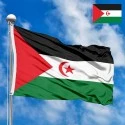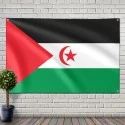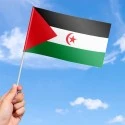The flag of the Sahrawi Arab Democratic Republic (SADR) is a powerful emblem of the struggle and aspirations of the Sahrawi people for self-determination and independence. Recognized by numerous states and international organizations, this flag symbolizes the nationhood declared by the Polisario Front in 1976. It proudly represents the Sahrawi Republic, encompassing a rich history of resistance, unity, and hope.
Design and Dimensions
The flag of the SADR is a horizontal tricolor of black, white, and green, with a red isosceles triangle positioned at the hoist. Superimposed on the white band, centrally, are a red crescent and star.
Symbolism of the Colors and Elements
Each color and element within the SADR flag carries profound historical, cultural, and political significance:
-
Black Stripe (Top): Represents the oppression, suffering, and colonial past endured by the Sahrawi people. It also symbolizes the dignity and steadfastness in the face of adversity.
-
White Stripe (Middle): Signifies peace, purity, and honesty. It embodies the Sahrawi people's desire for a peaceful resolution to their conflict and their commitment to justice and truth.
-
Green Stripe (Bottom): Symbolizes prosperity, hope, and the fertile land of the Western Sahara. It also alludes to the Islamic heritage and the rich natural resources of the region.
-
Red Isosceles Triangle (Hoist Side): This striking red triangle represents the blood shed by the Sahrawi martyrs in their fight for freedom and independence. It is a tribute to the sacrifices made for their nation's liberation.
-
Red Crescent and Star (Centered on White Stripe): These are traditional Islamic symbols, representing faith, guidance, and the spiritual unity of the Sahrawi people, a predominantly Muslim population. The crescent signifies progress and the star, enlightenment and hope for the future.
History of Creation and Adoption
The flag of the Sahrawi Arab Democratic Republic has its roots in the Pan-Arab colors (black, white, green, and red), which symbolize Arab unity and liberation. These colors are prominent in the flags of many Arab nations, reflecting a shared heritage and aspiration.
The design was officially adopted by the Polisario Front – the liberation movement of the Sahrawi people – on February 27, 1976, when the Sahrawi Arab Democratic Republic was proclaimed in Bir Lehlou. This date marked a pivotal moment in the Sahrawi struggle, following the withdrawal of Spain from Western Sahara and the subsequent invasion by Morocco and Mauritania. The flag was created to serve as a visual declaration of the nascent state's sovereignty and a rallying point for the Sahrawi cause.
Country, Region, and Acceptance
The Sahrawi Arab Democratic Republic (SADR) claims sovereignty over the entire territory of Western Sahara, a non-self-governing territory recognized by the United Nations. The SADR is a partially recognized state, with its government-in-exile (and de facto control over parts of the territory east of the Moroccan Wall, known as the "Free Zone") operating primarily from refugee camps in Tindouf, Algeria.
-
Region: Western Sahara is located in the Maghreb region of North Africa, bordering Morocco to the north, Algeria to the east, Mauritania to the south and east, and the Atlantic Ocean to the west.
-
Acceptance: The SADR is a full member of the African Union (AU) and is recognized by over 80 UN member states, though many have since withdrawn or frozen their recognition under pressure. Its flag is displayed at AU summits and other international gatherings where the SADR is represented. The flag's acceptance symbolizes international solidarity with the Sahrawi people's right to self-determination.
Significance for the Inhabitants
For the Sahrawi people, whether living in the refugee camps, in the Moroccan-occupied territories, or in the diaspora, their flag is far more than just a piece of cloth.
-
Symbol of Identity and Resistance: It is a powerful symbol of their unique Sahrawi identity and their ongoing resistance against occupation. It represents their unwavering commitment to their national cause.
-
Hope for Self-Determination: The flag embodies the hope and aspiration for a sovereign, independent state where they can fully exercise their right to self-determination.
-
Unity and Solidarity: It serves as a unifying emblem, fostering solidarity among Sahrawi communities dispersed by conflict and displacement. It reminds them of their shared struggle and common goal.
-
Tribute to Martyrs: The red triangle, in particular, acts as a constant reminder of the sacrifices made by those who perished for the Sahrawi cause, reinforcing their resolve.
-
Cultural Heritage: The Islamic symbols on the flag connect the Sahrawi people to their deep cultural and spiritual heritage, reinforcing their resilience.
Interesting Facts
-
Pan-Arab Influence: The design directly reflects the Pan-Arab flag template, emphasizing the Sahrawi people's Arab identity alongside their distinct national identity.
-
Flag of a State in Exile: The SADR flag is one of the few national flags primarily representing a government-in-exile with limited de facto control over its claimed territory, making its widespread recognition even more significant.
-
Symbol of Persistence: Its continued use and recognition, despite the protracted conflict, underscore the persistence and determination of the Sahrawi people in their quest for independence.
-
Display in Refugee Camps: The flag is prominently displayed in the Sahrawi refugee camps in Tindouf, Algeria, serving as a constant reminder of their national aspirations and the temporary nature of their displacement.
-
International Visibility: The SADR flag's presence at African Union events and in diplomatic contexts highlights its status as a recognized political entity within the international community, albeit contested.
-
Emblem of a Future State: For the Sahrawi people, the flag is not just a symbol of their current struggle but also a visual representation of the future independent state they envision.
In the demonstration images, full-size flags are shown with proportions of 2:3, and hand-held flags with proportions of 1:2.






 Waving flag
Waving flag
 Sizes:
Sizes:
 Round flag
Round flag
 Sizes:
Sizes:
 Rectangular flag 2:3
Rectangular flag 2:3
 Sizes:
Sizes: